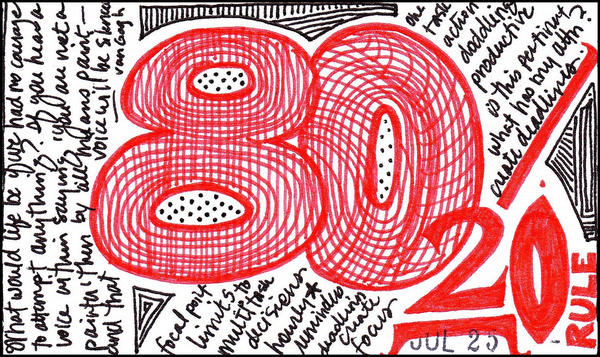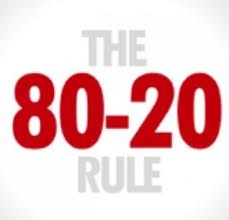Unleashing the Strength of 80/20
 In 1906, Italian Economist Vilfredo Pareto observed that the 80% of land in Italy was owned by 20% of population. Pareto also observed that 20% of the pea pods in his garden contained 80% of the peas. He went ahead and carried out surveys on distribution of wealth in different countries and found to his surprise that a similar distribution applied; 20% population in a country owned 80% of wealth.
In 1906, Italian Economist Vilfredo Pareto observed that the 80% of land in Italy was owned by 20% of population. Pareto also observed that 20% of the pea pods in his garden contained 80% of the peas. He went ahead and carried out surveys on distribution of wealth in different countries and found to his surprise that a similar distribution applied; 20% population in a country owned 80% of wealth.
The distribution is claimed to appear in several different aspects relevant to entrepreneurs and business managers. For example, 80% of a company’s profits come from 20% of its customers, 80% of a company’s complaints come from 20% of its customers, 80% of a company’s profits come from 20% of the time its staff spend, 80% of a company’s sales come from 20% of its products, 80% of a company’s sales are made by 20% of its sales staff. I add here, 80% of taxes are collected from 20% taxpayers in a country.
 Quality Management pioneer, Dr. Joseph Juran, working in the US in the 1930s and 40s recognized a universal principle which he called the “vital few and trivial many”. While Juran decided to make notes on the principle, in an early work, a lack of exactness on Juran’s part made it appear that he was applying Pareto’s observations about economics to a broader body of work. Hence the name Pareto’s Principle stuck, probably because it sounded better than Juran’s Principle.
Quality Management pioneer, Dr. Joseph Juran, working in the US in the 1930s and 40s recognized a universal principle which he called the “vital few and trivial many”. While Juran decided to make notes on the principle, in an early work, a lack of exactness on Juran’s part made it appear that he was applying Pareto’s observations about economics to a broader body of work. Hence the name Pareto’s Principle stuck, probably because it sounded better than Juran’s Principle.
In our personal lives also roughly 80% of the effects come from 20% of the cause. In business the 80-20 rule is used to help managers identify problems and determine which operating factors are most important and should receive the most attention based on an efficient use of resources. Resources should be allocated to address the input factors that have the most effect on a company’s final results. The moment, the 20% is recognized; trivial 80% can be sorted out without much fretting on it. While Pareto observed 20 percent of the people owned 80 percent of the wealth, Juran’s initial work identified that 20 percent of the defects caus 80 percent of the problems. Project Managers know that 20 percent of the work (the first 10 percent and the last 10 percent) consume 80 percent of time and resources. It is astonishing but, you can apply the 80/20 Rule to almost anything, from the science of management to the physical world.
If we keenly observe in our personal life, we use 20% of clothes in our wardrobe regularly and the balance 80% are rarely used by us. 20% of our friends make up 80% of our social life. 20% of our personal problems consume 80% of our energy and time. 20 percent of stocks give us 80% profits. You go to book a railway ticket, airline ticket, go to pay electricity bill go to a bank or a hospital anywhere if you observe keenly, you will see that 20% of the staff takes on 80% responsibilities. Similarly, police investigations reveal that 80% of accidents are caused by nearly 20% of drivers and that 80% of crime is committed by 20% of criminals. I want to add an interesting point here: Pareto had argued that democracy was an illusion and that a ruling class always emerged and enhanced its own interests. For him, the key question was how actively the head of states ruled. For this reason he called for a radical reduction of the state and welcomed Benito Mussolini’s rule so as to liberate the “pure” economic forces.
Jack Welch applied this theory at General Electric (GE) during his 20 years leadership span. His dynamism and vision was impeccable, GE increased in value more than 30 times to become the world’s richest corporation—and the world’s second biggest in market value. Welch had his own version of 80/20, designed to weed out the trivial many and focus on the vital few. He broke staffing down to a “vitality curve” of three segments. His A – list consisted of the top tier (20 percent) who performed best and earned the biggest bonuses. The B list (60 percent) included managers with a potential to rise to the top. The C-list consisted of people who were positioned at the bottom and were eventually dismissed (20 percent). Welch was blunt and courageous, undisturbed about being popular. Results mattered most. Here’s what he said about downsizing: “Strong managers who make tough decisions to cut jobs provide the only true job security in today’s world. Weak managers are the problem. Weak managers destroy jobs.”
impeccable, GE increased in value more than 30 times to become the world’s richest corporation—and the world’s second biggest in market value. Welch had his own version of 80/20, designed to weed out the trivial many and focus on the vital few. He broke staffing down to a “vitality curve” of three segments. His A – list consisted of the top tier (20 percent) who performed best and earned the biggest bonuses. The B list (60 percent) included managers with a potential to rise to the top. The C-list consisted of people who were positioned at the bottom and were eventually dismissed (20 percent). Welch was blunt and courageous, undisturbed about being popular. Results mattered most. Here’s what he said about downsizing: “Strong managers who make tough decisions to cut jobs provide the only true job security in today’s world. Weak managers are the problem. Weak managers destroy jobs.”
At Hewlett-Packard, Google, 3M when a person is hired, he/she has to work for 80% time of what he/she is assigned to do, the rest of 20% time, the employee can work on whatever he/she likes. This provided, brings in some advancement to the company. What does this mean? It means these companies are ready to take challenges; the 20% silver lining has helped them in bringing the creativity angle in their work culture.
We see many business corporations today applying the 80-20 principle brilliantly to their advantages. They are moving towards owning information and not land and assets. Knowledge is the key. Genuine macro and micro information helps in understanding customer’s pulse, market pulse, rival’s strategy, supplier’s whims etc. Organizations are using information to build better products and deliver enhanced service to increase profits; thus paying less attention to the trivial issues.
Organizations have realized that their 80% profits come from 20% niches and it’s vital for them to recognize those niches; like Jeff Bezos did with Amazon. Closer home, companies like HDFC, Lemon Tree Hotels, Marico, Vedant and Cafe Coffee Day have indentified and focused on their own niches. Only a niche delivers an outstanding return. It is important for organizations to choose a niche out of various niches recognized by them and invest and work successfully on the chosen niche. The idea applied by successful firms is to maximize the returns with minimum efforts, by making use of the 80/20 practices. Steve jobs, Bill Gates, Sergey Brin & Larry Page and Mark Zukerberg are people who have created wealth by focusing on the niche.
 80/20 helps a business firms as well as individuals to focus on what they are good at. Once the strengths are known, by making few amendments one can start effective delivery. Identifying Top 20 Percent is very important. The first way to determine which 20 percent of work you do yields 80 percent of the results; making you think back; by applying backward integration. What were the most important projects you completed last year that pushed your company forward? Your answers will include the types of projects that belong in your top 20 percent skill and core competency. Next, would you follow the same path or you want to diversify a bit, take a call.
80/20 helps a business firms as well as individuals to focus on what they are good at. Once the strengths are known, by making few amendments one can start effective delivery. Identifying Top 20 Percent is very important. The first way to determine which 20 percent of work you do yields 80 percent of the results; making you think back; by applying backward integration. What were the most important projects you completed last year that pushed your company forward? Your answers will include the types of projects that belong in your top 20 percent skill and core competency. Next, would you follow the same path or you want to diversify a bit, take a call.
The second way to determine your top tasks to perform is to review your to-do list and consider the following questions when appraising each point: does that activity really add value to your company? Are you armed with the resources for performing the task? Can you see someone else doing the job better than you do? Do you need to refurbish your abilities? Finally, a great way to determine which tasks are not in your top 20 percent is to keep a running list of low-value tasks. To begin with, you cannot be performing tasks that can be valued low. The next step in the process is to delegate the lowest value uses to others.
Pareto’s Principle, the 80/20 rule, should serve as a daily reminder to focus 80 percent of your time and energy on the 20 percent of you work that is really important. Don’t burn your fuel on trivial many instead concentrate on vital few. Work smart!!!












































